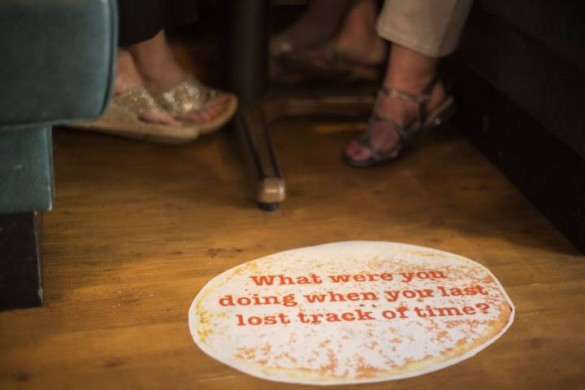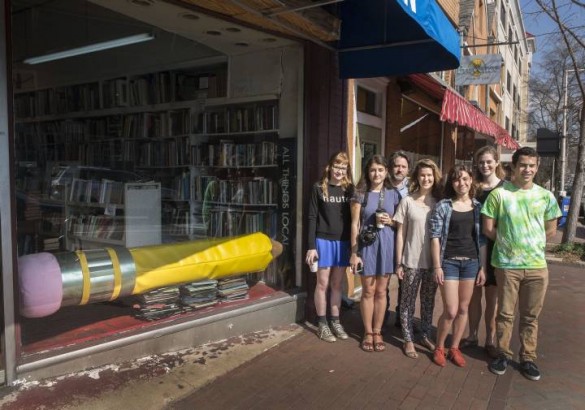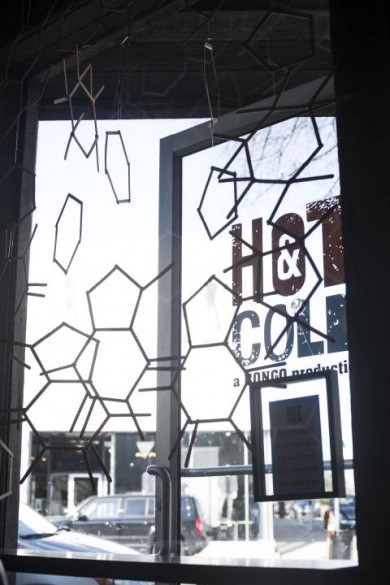
Engaging installations on display in Hillsboro Village businesses through April 15 have been created by a Vanderbilt University studio art class.
The exhibition, “Look Both Ways,” was designed by eight students enrolled in a course taught by Mel Ziegler, professor and chair of the Department of Art.
“Each student worked individually with a Hillsboro Village proprietor to build artwork designed to prompt a creative response related to the store’s mission,” Ziegler said. The course is called “Installation Art and Social Interventions.”
At Hot & Cold, which serves beverages and desserts, Peabody College senior Allyson Patterson of Memphis, Tennessee, used coffee sleeves and popsicle sticks to create an installation that represents the chemical structures of caffeine and sugar.
Emily Neal’s installation at A Village of Flowers features large honeycomb-like structures to remind viewers of the process of pollination and the importance of bees and flowers to life on earth. Neal, from Greenville, South Carolina, is a senior in the College of Arts and Science.
A gigantic pencil in the window of BookManBookWoman, which sells new and gently used books, was designed by Arts and Science sophomore Shannon Setili. “My installation emphasizes the very concrete, painstaking and personal process of writing, as well as the preternatural quality of the words,” said Setili, who is from Nashville, Tennessee.
Christian Santiago, a first-year student in the College of Arts and Science, created his installation at Festivity, a boutique focusing on women’s clothing, accessories and gifts. Santiago, who is also from Nashville, Tennessee, selected feminine apparel from the middle of the 20th century to show the link between contemporary women’s clothing and the roots from which the fashion may have originated.
At Pancake Pantry, Jamie Cohen considered that waiting in line has become an integral part of the experience for many of the restaurant’s customers. “I want to strengthen human relationships at a time when there is so much focus on digital technology,” said Cohen, a sophomore in the School of Engineering from Davie, Florida. Her installation contains questions designed to initiate conversation and engagement among waiting guests.

The installation at Fido, a coffeehouse and restaurant, seeks to bring guests into a dialogue during the commonly shared experience of doodling, according to Lucy Gonzalez, an Arts and Science junior from Dublin, Ohio. Customers are encouraged to draw on the napkins while waiting in line, dining and conversing with other patrons.
Chelsea Velaga, a senior in the College of Arts and Science from Nashville, Tennessee, created her installation at Village Jewelers. A theme of her artwork is that jewelry is often enjoyed for aesthetic and social reasons, while its natural sedimentary origins tend to be forgotten. “In juxtaposing amorphous 3-D printed forms with precision-cut jewels and metals, the origins are referenced, despite the industrialized means with which they are mined,” Velaga said. “At times, the jewels interact with the landforms, while other display cases will have more subtle interactions of the prints and the jewels.”
At Tennessee Chic, which offers vintage clothing and items made in Nashville, Gabby Nesi arranged everyday clothespins into an American flag to symbolize the idea of “Be American. Buy American.” “I wanted to start a dialogue concerning the issues of locality and origin,” said Nesi, a senior in the College of Arts and Science from Garden City, New York.
For more information on “Look Both Ways,” contact Mel Ziegler or call 615-343-7241.
